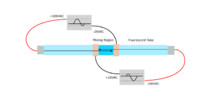The attached diagram shows a concept for signal mixing within a plasma tube. I am looking for comments regarding its viability in terms of electrodynamics and hardware design. The voltages shown are intended to relate to an ordinary fluorescent tube after triggering.
I would also appreciate suggestions on the simplest way to generate 100VAC audio frequency signals with the differing DC offsets as illustrated below.

I would also appreciate suggestions on the simplest way to generate 100VAC audio frequency signals with the differing DC offsets as illustrated below.


